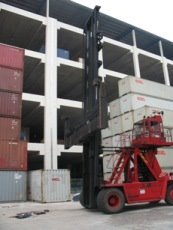
Case 1: Toppled Forklift Takes a Life...
While travelling along a temporary access way in a worksite, a forklift suddenly toppled into an embankment area undergoing some excavation works. The forklift operator, who had not attended any formal training, was pinned by the forklift and died in hospital on the same day. MOM issued a full stop work order on the premises. Investigation is on-going.
 Case 2: Side Loader Hits Depot Manager…
Case 2: Side Loader Hits Depot Manager…A fatal accident occurred in a factory carrying out storage and service of containers. While driving a side loader with the intention to load a container onto a trailer, the driver hit and killed a depot manager. MOM had stopped all works involving the use of side loaders in the factory. Investigation of the accident is in progress.
Fend off potential forklift accidents by picking up some priceless lessons from the past. The Japan International Center for Occupational Safety and Health (JICOSH) has developed an extensive archive of forklift case studies complete with clever illustrations and preventive tips. To lift up your knowledge on forklift accidents, click HERE.
Advisory Note (Please note that the advisory note is provided for the benefits of enhancing workplace safety and health, in no way the information is to be misconstrued as implying any liability on any party)
- Prior to work commencement, a risk assessment shall be conducted in relation to the safety and health risks posed to any person carrying out the work.
- Safety measures should be implemented to control the human and vehicle traffic so as to prevent accidental collision and to ensure that the boundaries between access way and excavated area are well-demarcated. Develop a traffic management plan for pedestrians and forklifts.
- Safe work procedures must be instituted, communicated and implemented to ensure the safety and health of workers involved.
- All counterbalanced forklift drivers must undergo all mandatory trainings and be qualified to operate forklifts.
- Undertake all safety procedures, including pre-use checks, before starting to use the forklift. Never disable the safety features such as seat safety switches and reversing beepers.
- Implement a control system for access to the forklift. Ignition key of forklift trucks should not be allowed to be left on the truck to allow unauthorized operation.
- Forklifts should not be overloaded and driven with the fork raised.
- Keep to a safe speed and never allow any passengers on a forklift.
- Forklift operators must use seatbelts for their own safety. Hold on firmly and remain in the cabin in the event of an overturn.
- Do not lift people using a forklift as forklifts are designed to lift and move loads.
- Avoid turning when operating on ramps or inclines.
- Travel in reverse when vision is blocked. Always sound the horn and slow down when approaching corners and intersections.
(This article was extracted from OSH ALert dated 26 Dec 2006 from the Ministry of Manpower, Singapore)




